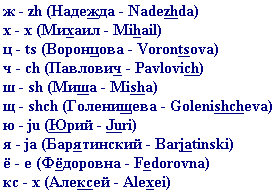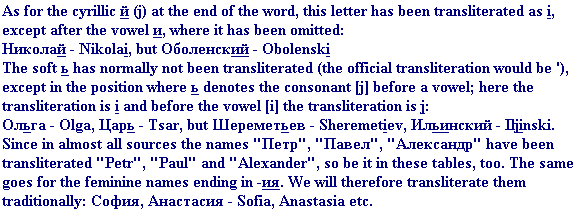
TRANSLITERATION
Wherever possible, the slavistic ("scientific") transliteration is used. This system is very similar to that of the ISO standard. However, to avoid diacritics, some rules of the Library of Congress transliteration have been applied. The following table may prove useful:


Thus, for instance, a double "ee" is transliterated just as it appears in cyrillic: "ee", and not "eye" or "eie" as you may see it in some transliterated texts. This or other transliteration aspects should not be a great problem because, after all, if somebody takes a serious interest in Russian history and the history of the Romanovs, at least some knowledge of Russian is necessary. If we visit the Cathedral of the Peter-Paul Fortress in St.-Petersburg to pay our respects to the Romanov family members buried there we really should be able to tell who lies where and to read the newest name plate attached in the Cathedral on July 17 1998.
GEOGRAPHICAL AND PERSON NAMES; TITLES
It is nice to say "Nice", but in these genealogical tables most geographical names appear in their original form: 'Nizza' instead of 'Nice', 'Moskva' instead of 'Moscow'. All German states preserve their German names: Sachsen, Braunschweig, Preussen, Hannover etc. These same principles have been applied to the person names: If Emperor Nikolai II called himself 'Nikolai' in his mother tongue, that is the way the name is printed in the table, too - not 'Nicholas'. Of course, some concessions have been made, especially with the German-British families where the original use of the names is often not quite clear: Leopold, Duke of Sachsen-Coburg-Gotha, was born in Surrey, died in Coburg, his son Hubertus Frederick served as a pilot in the Luftwaffe. Hubertus's comrades certainly called him Hubert Friedrich, but we don't know about his father's manners.
As for the noble titles, the title "Prince" gives us some headache. As we know, in German there are two kinds of princes: "Fürst" and "Prinz", and the Russian title "Knjaz'" or "Velikij Knjaz'" means exactly the German "Fürst" or "Grossfürst" - there were no princes in Russia. To avoid any mess, all princes will be called just "Princes" in the tables and charts.
The title "Tsarina" is often wrongly used to denote the Tsar's wife. The correct title should be "Tsaritsa", which was commonly used, too, although the official title was "Imperatritsa", Empress. For the female Romanovs before Peter I The Great we shall use the correct form "Tsaritsa". The daughters of all Tsars and Emperors were usually called Grand Duchesses. Actually, we only know one "real" Tsarevna: regent Sofia. The title "Tsarevich", on the other hand, was in use till 1918.
Until the Ukaz of Alexander III there were all too many Grand Dukes and Grand Duchesses in Russia. In the name index all these Grand Dukes and Duchesses may look all alike. I have therefore taken the liberty to add the words "of Russia" to denote the children of the rulers. Thus, "Konstantin Pavlovich, Grand Duke of Russia" indicates that this very Konstantin was a son of an emperor.
